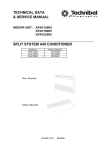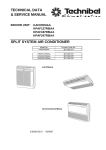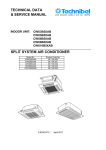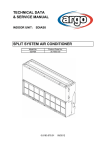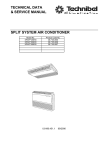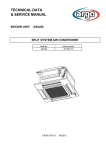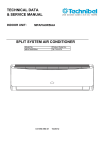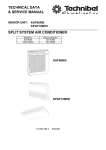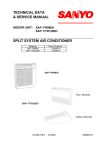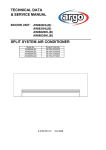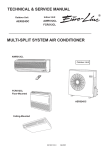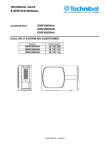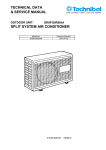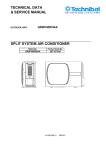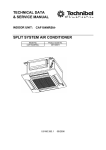Download technical data & service manual split system air conditioner
Transcript
TECHNICAL DATA & SERVICE MANUAL INDOOR UNIT: KPAF128C5TAA KPAF188C5TAA KPAF228C5TAA SPLIT SYSTEM AIR CONDITIONER Model No. KPAF128C5TAA KPAF188C5TAA KPAF228C5TAA Product Code No. 387105979 387105980 387105981 0.8180.570.0 04/2009 • Ground the unit following local electrical codes. • The Yellow/Green wire cannot be used for any connection different from the ground connection. • Connect all wiring tightly. Loose wiring may cause overheating at connection points and a possible fire hazard. • Do not allow wiring to touch the refrigerant tubing, compressor, or any moving parts of the fan. • Do not use multi-core cable when wiring the power supply and control lines. Use separate cables for each type of line. IMPORTANT! Please read before installation This air conditioning system meets strict safety and operating standards. For the installer or service person, it is important to install or service the system so that it operates safely and efficiently. For safe installation and trouble-free operation, you must: • Carefully read this instruction booklet before beginning. • Follow each installation or repair step exactly as shown. • Observe all local, state and national electrical codes. • Pay close attention to all warning and caution notices given in this manual. •The unit must be supplied with a dedicated electrical line. When transporting Be careful when picking up and moving the indoor and outdoor units. Get a partner to help, and bend your knees when lifting to reduce strain on your back. Sharp edges or thin aluminium fins on the air conditioner can cut your fingers. WARNING When installing... This symbol refers to a hazard or unsafe practice which can result in severe personal injury or death. … In a ceiling Make sure the ceiling is strong enough to hold the unit-weight. It may be necessary to build a strong wooden or metal frame to provide added support. CAUTION … In a room Properly insulate any tubing run inside a room to prevent "sweating", which can cause dripping and water damage to walls and floors. This symbol refers to a hazard or unsafe practice which can result in personal injury or product or property damage. ... In moist or uneven locations Use a raised concrete base to provide a solid level foundation for the outdoor unit. This prevents damage and abnormal vibrations. If necessary, get help These instructions are all you need for most installation sites and maintenance conditions. If you require help for a special problem, contact our sale/service outlet or your certified dealer for additional instructions. ... In area with strong winds Securely anchor the outdoor unit down with bolts and a metal frame. Provide a suitable air baffle. In case of improper installation The manufacturer shall in no way be responsible for improper installation or maintenance service, including failure to follow the instructions in this document. ... In a snowy area (for heat pump-type systems) Install the outdoor unit on a raised platform that is higher then drifting snow. Provide snow vents. SPECIAL PRECAUTIONS When connecting refrigerant tubing • During installation, connect before the refrigerant system and then the wiring one; proceed in the reverse orden when removing the units. • Keep all tubing runs as short as possible. • Use the flare method for connecting tubing. • Apply refrigerant lubricant to the matching surfaces of the flare and union tubes before connecting them; screw by hand and then tighten the nut with a torque wrench for a leak-free connection. • Check carefully for leaks before starting the test run. WARNING When wiring ELECTRICAL SHOCK CAN CAUSE SEVERE PERSONAL INJURY OR DEATH. ONLY QUALIFIED, EXPERIENCED ELECTRICIANS SHOULD ATTEMPT TO WIRE THIS SYSTEM. NOTE: Depending on the system type, liquid and gas lines may be either narrow or wide. Therefore, to avoid confusion, the refrigerant tubing for your particular model is specified as narrow tube for liquid, wide tube for gas. • Do not supply power to the unit until all wiring and tubing are completed or reconnected and checked, to ensure the grounding. • Highly dangerous electrical voltages are used in this system. Carefully refer to the wiring diagram and these instructions when wiring. Improper connections and inadequate grounding can cause accidental injury and death. When servicing • Turn the power OFF at the main power board before opening the unit to check or repair electrical parts and wiring. • Keep your fingers and clothing away from any moving parts. • Clean up the site after the work, remembering to check that no metal scraps or bits of wiring have been left inside the unit being serviced. • Ventilate the room during the installation or testing the refrigeration system; make sure that, after the installation, no gas leaks are present, because this could produce toxic gas and dangerous if in contact with flames or heat-sources. 2 Table of Contents Page 1. SPECIFICATIONS 1-1 Unit specifications 1-2 Major Component specifications 1-3 Other Component specifications 4 4 7 10 2. DIMENSIONAL DATA 11 3. ELECTRICAL DATA 3-1 Electric Wiring Diagram 3-2 Wiring System Diagrams 12 12 13 4. FUNCTION 4-1 Cool Mode Operation 4-2 Dry Mode Operation 4-3 Fan Mode Operation 4-4 Auto Fan Speed 4-5 Forced Mode 4-6 Protection Operations in Cool and Dry Modes 4-7 I FEEL Function 4-8 NIGHT Function 4-9 Diagnostic 4-10 Jumpers Configuration 4-11 Contacts for Building Automation 4-12 Maintenance 14 14 15 15 15 16 16 17 17 18 18 19 20 5. TROUBLESHOOTING 5-1 Check before and after troubleshooting 5-2 Circuit Breaker Trips or Fuse Blows 5-3 Circuit Breaker in several minutes after turning air conditioner on 5-4 Unit and Compressor do not run 5-5 Some parts of the Air Conditioner do not operate 5-6 Air Conditioner operates, but abnormalities are observed 5-7 Poor Cooling 5-8 Excessive Cooling 5-9 If a Sensor is defective 21 21 21 21 22 23 24 26 27 27 6. CHECKING ELETRICAL COMPONENTS 6-1 Measurement of Insulation Resistance 6-2 Checking Continuity of Fuse on PCB Ass'y 6-3 Checking Motor Capacitor 28 28 29 29 3 1. SPECIFICATIONS 1-1 Unit Specifications KPAF128C5TAA Power source 220 - 240V ~ 50Hz Voltage rating 230 V - 50 Hz Performance Capacity Air circulation (High) Features Controls/Temperature controls Control unit Timer Fan speed Airflow direction Air Filter Power noise level Refrigerant tubing connections Refrigerant tube diameter Refrigerant Dimensions & Weight Unit dimensions Package dimensions Weight m³/h High Narrow tube Wide tube dB-A mm(in.) mm(in.) Height Width Depth Height Width Depth Net Shipping mm mm mm mm mm mm kg kg m3 Shipping volume 4 Cooling See catalogue with the requested matching 700 Microprocessor/ I.C. thermostat Wireless remote control unit ON/OFF 24 hours 3 and Auto Auto (Remote control) Washable, easy acces, long life (2500 hr.) 55 Flare type 6,35 (1/4) 12,7 (1/2) R410A 680 900 190 770 995 280 23,5 31,5 0,21 DATA SUBJECT TO CHANGE WITHOUT NOTICE KPAF188C5TAA Power source 220 - 240V ~ 50Hz Voltage rating 230 V - 50 Hz Performance Capacity Air circulation (High/Med./Low) Features Controls/Temperature controls Control unit Timer Fan speed Airflow direction Air Filter Power noise level Refrigerant tubing connections Refrigerant tube diameter Refrigerant Refrigerant control Dimensions & Weight Unit dimensions Package dimensions Weight m³/h High/Med./Low Narrow tube Wide tube dB-A mm(in.) mm(in.) Height Width Depth Height Width Depth Net Shipping mm mm mm mm mm mm kg kg m3 Shipping volume 5 Cooling See catalogue with the requested matching 720/615/515 Microprocessor/ I.C. thermostat Wireless remote control unit ON/OFF 24 hours 3 and Auto Auto (Remote control) Washable, easy acces, long life (2500 hr.) 56/52/47 Flare type 6,35 (1/4) 12,7 (1/2) R410A Capillary tube 680 900 190 770 995 280 23,5 31,5 0,21 DATA SUBJECT TO CHANGE WITHOUT NOTICE KPAF228C5TAA Power source 220 - 240V ~ 50Hz Voltage rating 230 V - 50 Hz Cooling See catalogue with the requested matching 830/760/665 m³/h Performance Capacity Air circulation (High/Med./Low) Features Controls/Temperature controls Control unit Timer Fan speed Airflow direction Air Filter Power noise level Refrigerant tubing connections Refrigerant tube diameter Refrigerant Refrigerant control Dimensions & Weight Unit dimensions Package dimensions Weight Shipping volume Microprocessor/ I.C. thermostat Wireless remote control unit ON/OFF 24 hours High/Med./Low Narrow tube Wide tube Height Width Depth Height Width Depth Net Shipping dB-A mm(in.) mm(in.) 3 and Auto Auto (Remote control) Washable, easy acces, long life (2500 hr.) 60/57/54 Flare type 6,35 (1/4) 15,88 (5/8) R410A Capillary tube 680 mm 900 mm 190 mm 770 mm 995 mm 280 mm 23,5 kg 31,5 kg 3 0,21 m DATA SUBJECT TO CHANGE WITHOUT NOTICE 1-2 Major Component Specifications KPAF128C5TAA Controller PCB Part No. Controls Control circuit fuse Jumper setting JP1..JP5 SAC ON-OFF IDU Microprocessor 250 V - 3,15 A 2,54mm-5pcs SAC W-REM Remote Control Unit Fan & Fan Motor Type Q'ty ……. Dia. and lenght Fan motor model…Q'ty No. of poles…rpm (230 V, High) Nominal output Running Amps Power input Coil resistance (Ambient temp. 25 °C ) Safety devices mm W A W Ω Type Operating temp. Open Close °C Run capacitor µF VAC Flap Motor Type Model Rating Coil resistance (Ambient temp. 25 °C ) Ω Heat Exch. Coil Coil Rows Fin pitch face area Cross - flow 2…. Ø 130 / L 180 K48407-M01596…1 4…1160 21 0,29 65 GRY-WHT: 298÷343 WHT-PNK: 421÷485 WHT-VLT: 93,5÷108 VLT-ORG: 93,5÷108 ORG-YEL: 211÷243 Thermal protection 145 ± 5 Automatic 1.5 440 Stepping motor MP24Z2 DC 12 V 400 ± 7% Aluminium plate fin / Copper tube 2 1,5 mm 0,177 m2 DATA SUBJECT TO CHANGE WITHOUT NOTICE 7 KPAF188C5TAA Controller PCB Part No. Controls Control circuit fuse Jumper setting JP1..JP5 SAC ON-OFF IDU Microprocessor 250 V - 3,15 A 2,54mm-5pcs Fan & Fan Motor Type Q'ty ……. Dia. and lenght Fan motor model…Q'ty No. of poles…rpm (230 V, High) Nominal output Running Amps Power input Coil resistance (Ambient temp. 25 °C ) Safety devices mm W A W Ω Type Operating temp. Open Close °C Run capacitor µF VAC Flap Motor Type Model Rating Coil resistance (Ambient temp. 25 °C ) Ω Heat Exch. Coil Coil Rows Fin pitch face area Cross - flow 2…. Ø 130 / L 180 K48410-MO1597…1 4…1280 31,5 0,34 72 GRY-WHT:194÷223 WHT-PNK: 238÷274 WHT-VLT: 80,1÷ 92,2 VLT-ORG: 80,1÷92,2 ORG-YEL: 200÷230 Thermal protection 145 ± 5 Automatic 2,0 440 Stepping motor MP24Z2 DC 12 V 400 ± 7% Aluminium plate fin / Copper tube 2 1,8 mm 0,192 m2 DATA SUBJECT TO CHANGE WITHOUT NOTICE 8 KPAF228C5TAA Controller PCB Part No. Controls Control circuit fuse Jumper setting JP1..JP5 SAC ON-OFF IDU Microprocessor 250 V - 3,15 A 2,54mm-5pcs Fan & Fan Motor Type Q'ty ……. Dia. and lenght Fan motor model…Q'ty No. of poles…rpm (230 V, High) Nominal output Running Amps Power input Coil resistance (Ambient temp. 25 °C ) Safety devices Type Operating temp. Open Close Run capacitor Flap Motor Type Model Rating Coil resistance (Ambient temp. 25 °C ) Heat Exch. Coil Coil Rows Fin pitch face area mm W A W Ω °C µF VAC Ω Cross - flow 2…. Ø 130 / L 180 K48410-M01598…1 4…1370 35 0,35 74 GRY-WHT: 124÷144 WHT-PNK: 255÷294 WHT-VLT: 69,3÷79,8 VLT-ORG: 69,3÷79,8 ORG-YEL: 200÷233 Thermal protection 145 ± 5 Automatic 2,0 440 Stepping motor MP24Z2 DC 12 V 400 ± 7% Aluminium plate fin / Copper tube 2 1,8 mm 0,192 m2 DATA SUBJECT TO CHANGE WITHOUT NOTICE 1-3 Other Component Specifications Thermistor ( Coil sensor TH1) Resistance ΚΩ 10 ± 3% Thermistor ( Room sensor ) Resistance kΩ NTC-THERMISTOR 10 at 25 °C 10 2. DIMENSIONAL DATA Units: mm 11 3. ELECTRICAL DATA 3-1 Electric Wiring Diagram KPAF128C5TAA KPAF188C5TAA KPAF228C5TAA 12 3-2 Wiring System Diagram KPAF128 GRF128L5 1-phase KPAF188 3-phase GRF188L5 model GRF188L7 GRF228L7 KPAF188 KPAF228 A power supply B control line delayed fuse m mm2 m mm2 GRF128 15 1,5 15 1,5 10 A GRF188 15 (85 * ) 1,5 16 A 25 2,5 GRF228 * 3 Phase version 15 (65 * ) 20 4.FUNCTION 4-1 Cool Mode Operation In Cooling Mode, the operation of the compressor (CM), Outdoor Fan (FMO) and Indoor Fan (FMI) are determined by the difference between the room air temperature (RAT) and the set point temperature (SPT) as shown in the graph. NOTES 1. In this graph, the FMI is operating with the “Auto Fan Speed” setting. If the user has selected the Low, Medium or High fan speed, the FMI will run constantly at that speed only. 2. In addition to the temperature difference of above, the operations of the main components (CM, FMO, FMI) is also controlled by protection delays. That is: - the minimum off time of compressor is 3 minutes. - the minimum off time of compressor is 3 minutes. - the indoor fan can change speed only after it has operated at the same speed for 30 sec if in AUTO and 1 sec for the other settings (High, Med, Low). 14 4-2 Dry Mode Operation Dry operation remove moisture from indoor air running, in cooling mode, at a low level without reducing the ambient temperature. This is done cycling ON and OFF indoor and outdoor units according to below. ROOM TEMP DRY LEVEL ≥ SPT+2°C LEVEL 0 < SPT+2°C ≥ SPT-1°C < SPT-1°C ≥ 15°C < 15°C Operation according to COOLING mode CM on FMO on FMI switches between L and LL (30 seconds) RV off CM switches 9 minutes off and 3 minutes on LEVEL 2 FMO switches 9 minutes off and 3 minutes ON FMI switches off and L during CM operation RV off CM off DRY OFF ZONE FMO off FMI off RV off LEVEL 1 SPT = Set Point Temperature 4-3 Fan Mode Operation With this mode, the indoor fan is turned on while CM, FMO and RV stay off all the time. The user can select between 3 speeds: HIGH, MEDIUM and LOW. 4-4 Auto Fan speed With this option selected, the indoor fan speed changes automatically according to the difference between the detected air temperature (RAT sensor) and the set point (SPT): COOLING MODE 2 ≤ (RAT – SPT): 1 ≤ (RAT – SPT) < 2: (RAT – SPT) < 1: HIGH speed MEDIUM speed LOW speed NOTE SPT = Set Point Temperature 15 4-5 Forced Mode In this mode the system operates (COOLING mode – fixed settings) or is switched off by means of the MODE button of the indoor unit control board. The operation modes can be selected pressing the button in a cyclic way (OFF ð COOL ð OFF…). The settings are: SET POINT temperature = 25°C FAN SPEED = HIGH 4-6 Protection operations in Cool and Dry Mode This protection prevents ice formation on the indoor coil heat exchanger. The protection is activated by the indoor coil temperature (ICT sensor) and only after 6 minutes of compressor operation. This protection acts in 2 levels: LEVEL 1 INDOOR FAN SPEED: ANY (as selected from remote controller) COMPRESSOR: ON OUTDOOR FAN: cycling (30 seconds ON B 30 seconds OFF). LEVEL 2 INDOOR FAN SPEED: ANY (as selected from remote controller) COMPRESSOR: OFF for at least 6 minutes and until ICT ≥ 8°C OUTDOOR FAN: OFF for at least 6 minutes and until ICT ≥ 8°C The system exit this protection routine when ICT temperature rises above 8°C. 16 4-7 I FEEL Function As standard configuration the air conditioner operates detecting the room temperature through the sensor equipped in the wireless remote controller (icon I FEEL shown on the display). This feature provides a personalised environment since the temperature can be detected where the remote controller is located. It is possible to de-activate this option pressing the I FEEL button on the remote controller. In this case the I FEEL icon is no longer displayed and room temperature is detected through the sensor included in the indoor unit. 4-8 NIGHT Function When this function is active, room temperature changes automatically to compensate for body temperature variations while sleeping. After 10 hours of operation system switches automatically to OFF state. 17 4-9 Diagnostic With this feature is possible to have a visual signal that a trouble is occurring. This mode is always active and the signalling is made through the display board LEDS . In case of no troubles the LEDS status follows its normal function. NOTES The troubles are showed according a priority list that is in case of more than one trouble present, is always showed, at first, the one with the highest priority (1 2 3 etc). Sensor damaged means a situation where sensor is short-circuited or opened. In case of damaged sensors, the system (CM, FMO, FMI etc), if in OFF state, does not start. WRONG MODE SELECTED means a situation where the operating mode chosen with remote controller does not comply with the one allowed by jumpers settings. Priority 2 3 4 LEDS status TROUBLE RAT damaged ICT damaged WRONG MODE SELECTED O = LED off z = LED on F = LED blinking Effects LD1(stby) LD2(opr) LD3(timer) F F F O F F O O F System does not operate System does not operate 4-10 JUMPERS CONFIGURATION Jumpers are located on the indoor PCB near the MODE button. Unit is shipped with jumpers set according to the following table: 18 JUMPER STATUS JP1 JP2 JP3 JP4 JP5 open closed open closed closed 4-11 Contacts for Building Automation 4-11.1 INPUT CONTACT (J4 - green) The status of this input affects system operation according to the following: Contact OPEN : system does not operate (always OFF) – inputs from wireless remote controller are not processed Contact CLOSED: system operates in the normal way according to the inputs coming from wireless remote controller 4-11.2 OUTPUT CONTACT (J12) This connector is directly tied to the contact (normally open) of a power relay which activates every time the following alarm condition occur: • RAT damaged • ICT damaged In this case when alarm happens, on poles 1 and 3 of J12 connector, 220 VAC-50Hz are available. Max electrical load: 1A- 240VAC 19 4-12 Maintenance Changing the Address of the Air Conditioner In case of more than one air conditioner operating in the same room, it may be necessary to assign an address to each unit in order to avoid operation conflicts. Address is set acting on the dip-switches located on the indoor PCB and on the remote controller. The PCB settings must match the corresponding ones on the wireless remote controller. How to change address of the air conditioner Dip switch is located on the indoor PCB near the buzzer. Set the PCB to the address desidered UNIT ADDRESS 1 2 3 4 SETTINGS SW1 SW2 off off off on on off on on As default switches SW1 and SW2 are in off status (PCB factory state). How to change address on Remote Control Unit Dip switch is located on the battery compartment. 1) Pull out the door and remove the batteries. 2) Set the switch SW1 and SW2 according to the indoor PCB settings (do not act on SW3 and SW4) 3) Insert the batteries and pull on the door As default switches SW1 and SW2 are in off status (remote controller factory state). 20 5. TROUBLESHOOTING 5-1 Check Before and After Troubleshooting (A) Check power supply wiring. • Check the power supply wires are correctly connected. (B) Check power supply. • Check that voltage is in specified range (±10% of the rating). • Check that power is being supplied. • WARNING: If the following troubleshooting must be done with power supplied, be careful not to touch any uninsulated live part that can cause eletric shock 5-2 Circuit Breaker Trips or Fuse Blows • When circuit breaker is set to ON, it trips in a few moments. Resetting is not possible. • Measure insulation resistance. There is a possibility of ground fault. If resistance value is 1 Mohm or less, insulation is defective. 5-3 Circuit Breaker Trips in Several Minutes After Turning Air Conditioner On 1 • There is the possibility of short circuit. 21 2 • The unit does not run. 5-4 Unit and Compressor Do Not Run The unit does not run when air conditioner is in the follwing conditions: • When the room temperature is below the setting temperature. • During the protection modes. 22 5-5 Some Parts of the Air Conditioner Do Not Operate 23 5-6 Air Conditioner Operates, but Abnormalities are Observed 24 25 5-7 Poor Cooling 26 5-8 Excessive Cooling 5-9 A Sensor Is Defective 27 6. CHECKING ELETRICAL COMPONENTS 6-1 Measurement of Insulation Resistance The insulation is in good condition if the resistance exceeds 1 MOhm a) Power Supply Wires Clamp the earthed wire of the power supply wires with the lead clip of the insulation resistance tester and measure the resistance by placing a probe on either of the power wires (fig.1). Then measure the resistance between the earthed wire and the other power wires (fig.1). b) Unit Clamp an alluminium plate fin or copper tube with the lead clip of the insulation resistance tester and measure the resistance by placing a probe on N terminal, and then on Lterminal the terminal plate (fig.2) c) Measurement of Insulation Resistance for Electrical Parts Disconnect the lead wires of the disired electric part from terminal plate, PCB assy, capacitor, etc. Similary disconnect the connector. Then measure the insulation resistance (fig.1 to 4). Refer to electric wiring diagram. NOTE If the probe cannot enter the poles because the hole is too narrow then use a probe with a thinner pin. 28 6-2 Checking Continuity of fuse on PCB assy Remove PCB assy from electrical component box (fig.5) Then pull out the fuse from PCB assy Check continuity of fuse by the multimeter (fig.6) 6-3 Checking Motor Capacitor Remove the lead wires from the capacitor terminals, and then place a probe on the capacitor terminals as shown in fig.7. Observe the deflection of the pointer, setting the resistance measuring range of the multimeter to the maximum value. The capacitor is "good" if the pointer bounces to a great extent and the gradually returns to its original position. The range of deflection and deflection time deffer according to capacity of the capacitor. 29 R.D. 28 Reyrieux BP 131 - 01601 Trévoux CEDEX France Tél. 04.74.00.92.92 - Fax 04.74.00.42.00 R.C.S. Bourg-en-Bresse B 759 200 728






























